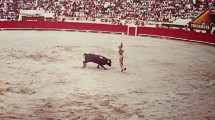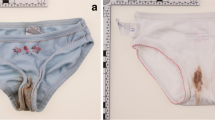Abstract
Freezing as a method for hiding a body is rare. We report here a homicide case in which three bodies were concealed in a freezer. This presented the pathologist with the problem of how to thaw the bodies and simultaneously avoid decomposition of the uppermost body. The problem was solved by slow thawing in a refrigerated morgue and by removing the bodies one after the other from top to bottom. The victims were a 27-year old mother and her two daughters, 7 and 9 years of age. The perpetrator was the 34-year old now-divorced husband and father. All were refugees from Syria. The perpetrator fled back to Syria. He was later arrested in Syria, confessed the crime and was sentenced to life imprisonment. The autopsy findings is discussed and compared to finding reported in the scientific literature.





Similar content being viewed by others
References
Preuß J, Strehler M, Dressler J, Riße M, Anders S, Madea B. Dumping after homicide using setting in concrete and/or sealing with bricks—six case reports. Forensic Sci Int. 2006;159:55–60.
Beauregard E, Martineau M. No body, no crime? The role of forensic awareness in avoiding police detection in cases of sexual homicide. J Crim Justice. 2014;42:213–20.
Beauregard E, Field J. Body disposal patterns of sexual murderers: implications for offender profiling. J Police Crim Psychol. 2008;23:81–9.
Zugibe FT, Costello JT. The Iceman murder: one of a series of contract murders. J Forensic Sci. 1993;38:1404–8.
Tabata N, Morita M, Azumi J. A frozen newborn infant: froth in the air-passage after thawing. Forensic Sci Int. 2000;108:67–74.
Kozawa S, Kakizaki E, Yukawa N. Autopsy of two frozen newborn infants discovered in a home freezer. Legal Med. 2010;12:203–7.
Micozzi MS. Experimental study of postmortem change under field conditions: effects of freezing, thawing, and mechanical injury. J Forensic Sci. 1986;31:953–61.
Schäfer AT, Kaufmann JD. What happens in freezing bodies? Experimental study of histological tissue change caused by freezing injuries. Forensic Sci Int. 1999;102:149–58.
Zappi EA, Zappi E. “Freezing artifacts” in human tissue samples: their formation and prevention. Cryobiology. 1981;18:301–5.
Muldrew K, McGann LE. Mechanisms of intracellular ice formation. Biophys J. 1990;57:525–32.
Leibo SP, Mazur P. The role of cooling rates in low-temperature preservation. Cryobiology. 1971;8:447–52.
Mazur P. Freezing of living cells: mechanisms and implications. Am J Physiol Cell Physiol. 1984;247:125–42.
Meryman HT. General principles of freezing and freezing injury in cellular materials. Ann N Y Acad Sci. 1960;85:503–9.
Baraibar MA, Schoning P. Effects of freezing and frozen storage on histological characteristics of canine tissues. J Forensic Sci. 1985;30:439–47.
Fanton L, Yappo-Ette H, Vianey-Saban C, Malicier D. Homicide followed by freezing and burning: usefulness of measuring SCHAD (short-chain 3-hydroxyacyl-CoA dehydrogenase) activity. J Clin Forensic Med. 2006;13:339–40.
Miras A, Yapo-Ette H, Vianey-Saban C, Malicier D, Fanton L. Method for determining if a corpse has been frozen: measuring the activity of short-chain 3-hydroxyacyl-CoA dehydrogenase (SCHAD). Forensic Sci Int. 2001;124:22–4.
Author information
Authors and Affiliations
Corresponding author
Rights and permissions
About this article
Cite this article
Olsen, T.B., Leth, P.M. Homicide victims concealed in a freezer. Forensic Sci Med Pathol 14, 386–389 (2018). https://doi.org/10.1007/s12024-018-9988-4
Accepted:
Published:
Issue Date:
DOI: https://doi.org/10.1007/s12024-018-9988-4




